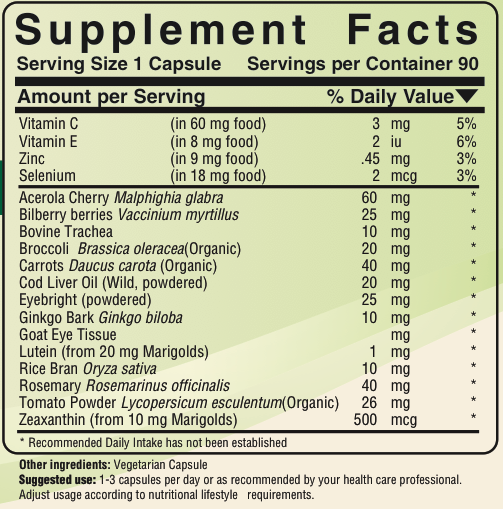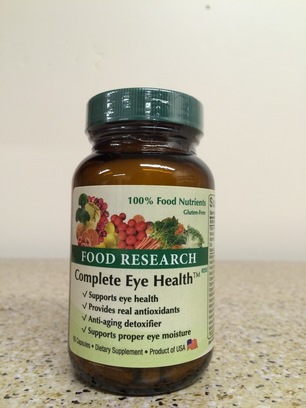
Complete Eye Health TM
90 Capsules $39.98
90 Capsules $39.98
Eye problems are exceptionally common. From cataracts, to macular degeneration, to retinopathy, to glaucoma, to night blindness, to simple focus and eye strain issues, there are numerous eye problems [1].
Although discounted by many in the mainstream for decades, scientific research confirms that there are nutrients in foods that can help provide support for eye health. For example, vitamins A, C, & E; taurine; carotenoids lutein and zeaxanthin; fruits & vegetables; selenium; and zinc all have been advised for macular degeneration [2,3]. While vitamin C, fruits, vegetables, flavonoids, mixed carotenoids, selenium, and zinc all have been advised to help prevent cataracts [1,2].
Complete Eye Health contains the following Foods:
Acerola cherry , Malphighia glabra is one of the most vitamin C dense Foods. Vitamin C is “[o]ne of the most important antioxidants in the eye” [1]. “Malphigia glabra also contains flavonoids. Flavonoids improve “night vision and adaptation to dark. Improves visual acuity and improves capillary integrity to reduce hemorrhage in diabetic retinopathy” [4]. Vitamin C has been advised for corneal ulcers, macular degeneration, and vascular retinopathy [5].
Bilberry berries of the Vaccinium myrtillus plant contain high amounts of the flavonoid compound, anthocyanosides. These compounds are believed to accelerate the resynthesis of rhodopsin, a chromoprotein in the retinal rods that stimulates the retinal sensory endings as it is formed and degraded. Anthocyanosides have been reported to modulate retinal enzyme activity. The antioxidant capacity of these bilberry anthocyanosides is believed to slow retinal angiopathy that occurs in age-related macular degeneration and diabetic retinopathy [6-8]. The anthocyanosides in bilberries help prevent the breakdown of vitamin C, which helps it protect the eyes [7]. “A group of Italian researchers showed that a mixture of anthocyanidins from bilberry plus vitamin E halted the progression of lens clouding in a remarkable 97 percent of people with early stage cataracts” [7]. Bilberry reportedly reduces eye strain, improves retinal sensitivity in myopia, and enhances night vision as well as macular recovery time, but is not recommended during pregnancy or nursing [8,9].
Bovine tracheal tissue supplies cartilage, which is a natural source of chondriotin sulfate-A. Cartilage has specifically been recommended “[t]o prevent or possibly halt the progression of the condition” of diabetic retinopathy [5].
Broccoli has specifically been recommended for maintaining healthy eyes [5]. Broccoli contains a variety of phytochemicals such as chlorophyll, lutein, and sulforaphane [4]. Sulforaphane “protects the eyes ‘from damage caused by UV light’ that can lead to macular degeneration” [10]. Broccoli also contains a plant form of vitamin K [11]. Plant vitamin K has been shown to have neuroprotective effects which aid the retina [12]. It appears that broccoli consumption is associated with reduced need for cataract surgery [13].
Carrots have long been used to help prevent night blindness (the ancient Greeks knew this). “[A] decade-long Harvard study indicat[ed] that by getting 50 milligrams of carotenoids in every other day…significantly reduce[d] the risk of cancer, cardiovascular disease, and cataracts” [7]. Carrots supply carotenoids such as betacarotene, a vitamin A precursor—vitamin A has specifically been advised to help those with dry eyes [5]. Betacarotene has been used to help reduce the the development of advanced age-related macular degeneration [14].
Cod liver oil supplies essential fatty acids and naturally contains vitamin A [15]. “Dry eyes generally stem from a lack of vitamin A” [5]. Essential fatty acids and vitamin A are recommended for dry eyes and sometimes floaters [5].
Copper has been studied as a nutrient to improve eye health [14]. Specifically, copper has been used to help reduce the development of advanced age-related macular degeneration [14] and now many ophthalmologists recommend it. It may of interest to note that bovine/goat tissues, tomatoes, Saccharomyces cerevisiae , and rice bran are among the best food sources of copper [16,17].
Gingko Biloba “may prevent degenerative changes in the eye” [1]. “Gingko extracts help maintain good blood flow to the retina”, has significantly improved “long-distance vision”, and is advised for macular degeneration [7].
Goat eye tissue supplies a complete variety of ocular peptides. Eye tissue extracts have “been found useful in nearly all uncomplicated eye conditions, such as ordinary eye strain and usual tissue changes associated with failing vision and the aging process…glaucoma, cataracts, iritis” [19]. Eye tissue has also been recommended for strabismus, far sightedness, and near sightedness, but not eye infections [18], though it appears more effective for eye-strain and aging-related eye complaints. Taurine, which is naturally found in retinal tissue [4], “[m]ay protect cells from harmful ultraviolet light” [1].
Lutein is naturally present in the macula of the human retina and is considered to be opthalmoprotective as it filters out potentially phototoxic blue light and near-ultraviolet radiation from the macula [4,19]. It may help protect against macular degeneration and cataract formation [3,4] Lutein esters have been found to increase macular pigment [4]. Lutein is recommended for those with diabetic retinopathy [3]. The lutein in Complete Eye Health is found from marigolds.
Rice bran is a natural Food source of B vitamins. Specifically, rice bran naturally contains vitamins B-1, B-2, B-3, B-5, B-6, and B-8, plus minerals [20]. B complex vitamins are recommended for eye health [1,5]. Rice bran also supplies potassium which is recommended to help with blurred vision [5].
Rosemary has antioxidant properties and is often used in products containing fish oils to prevent rancidity. Antioxidants are often advised for eye health. Furthermore, rosemary contains carnosic acid, which promotes the production of the nerve growth factor necessary for the growth and function of healthy nerve tissue [21]. Nerve growth factors may have a retinal protective effect [22]. Carnosic acid in rosemary has similar antioxidant properties to vitamin E [23].
Selenium “may help prevent cataracts. Visual acuity improved in patients supplemented with selenium and vitamin E” [1].
Tomato powder supplies lycopene. “Lycopene is an acyclic isomer of beta-carotene” [4]. One nutritional study found that the risk of cortical cataract was lowest in individuals with the highest plasma levels of lycopene [24]. Lycopene in tomato powder appears to be more bioavailable than that in fresh tomatoes, and tomato powder has (by weight) 26-144 times more lycopene than fresh tomatoes [4].
Vitamin E “A deficiency of this important antioxidant may lead to cataracts” [1]. Food (vegetable) forms of vitamin E are up to 4 or more times the free radical scavenging strength [25]. Vitamin E has specifically been used to help reduce the development of advanced age-related macular degeneration [14].
Zeaxanthin is naturally concentrated in the macula of the human retina and is considered to be opthalmoprotective as it filters out potentially phototoxic blue light and near-ultraviolet radiation from the macula [4,15]. It may help protect against macular degeneration and cataract formation [3,4]. “Z eaxanthin is the predominant pigment in the fovea, the region in the center of the macula” [4]. The zeaxanthin in found Complete Eye Health is from marigolds.
Zinc is “[n]ecessary for normal visual function and adaptation to dark. Zinc deficiency may lead to cataracts, and supplementation reduces visual loss in macular degeneration” [1]. Zinc has specifically been used to help reduce the the development of advanced age-related macular degeneration [14].
Several of the foods and nutrients in Complete Eye Health are also recommended for thinning eyelashes [5]. Interestingly, e ven the mainstream now recognizes that nutrients from Foods, and not isolated so-called nutritional supplements, are what are best to help protect eyes from problems such as macular degeneration [26,27].
Your vision is important. Complete Eye Health is the only complete 100% Food supplement we are aware of intended to nutritionally support the eyes.
Complete Eye Health also naturally contains carbohydrates, lipids, proteins (including all ten essential amino acids), and truly organic bioflavonoids as found in specially grown, enzymatically processed Saccharomyces cervisiae and vegetable oils. Unlike many so-called “natural” formulas, Complete Eye Health is only comprised of foods, contains no synthetic USP nutrients or isolated mineral salts, but only contains foods, food complexes, and food concentrates.
Numerous university studies have concluded that supplements containing food nutrients are better than USP isolates. Food nutrients are better because they contain important enzymes, peptides, and phytonutrients CRITICAL to the UTILIZATION of vitamins and minerals which are not present in isolated USP nutrients. Published research has concluded that food vitamins are superior synthetic/USP vitamins.
Suggested use: 1-3 capsules; per day or as recommended by your health care professional. Adjust usage according to nutritional lifestyle requirements.
References
[1] Strohecker J, ed. Alternative Medicine, The Definitive Guide. Future Medicine Publishing, Fife (WA), 1995
[2] Werbach MR, Moss J. Textbook of Nutritional Medicine. Third Line Press, Tarzana (CA) 1999
[3] Colchamiro R. Pigments in fruits, vegetables fight cancer, aid vision. Med Tribune, December, 1999:8
[4] Sheldon S, Rorvik D, eds. PDR for Nutritional Supplements. Medical Economics, Montvale (NJ), 2001
[5] Balch JF, Balch PA. Prescription for a Nutritional Healing, 2 nd ed. Avery Publishing, Garden City Park (NJ), 1997
[6] Walsh N. Bilberry Extract for Night Vision. Fam Prac News, July 15, 2004:21
[7] Duke JA. The Green Pharmacy. Rodale Press, Emmaus (PA), 1997
[8] Gruenwald J, Brendler T, Jaenicke C, eds. PDR for Herbal Medicine, 3rd ed. Thomson PDR, Montvale (NJ), 2004
[9] Anthocyanins and Blueberries. Nutr Week, October 3, 1997;27(38):7
[10] Douglas WC. Visions of brocolli. Real Health Breakthroughs, 2005;4(8):1,3
[11] Broccoli, raw. USDA National Nutrient Database for Standard Reference, Release 17, 2004
[12] Carrie I, Ferland G, Obin MS. Effects of long-term vitamin K (phylloquinone) intake on retina aging. Nutr Neurosci. 2003;6(6):351-359
[13] Moeller SM, Jacques PF, Blumberg JB. The potential role of dietary xanthophylls in cataract and age-related macular degeneration. J Am Coll Nutr. 2000;19(5 Suppl):522S-527S
[14] Age-Related Eye Disease Study Research Group. A Randomized, Placebo-Controlled, Clinical Trial of High- Dose Supplementation With Vitamins C and E, Beta Carotene, and Zinc for Age-Related Macular Degeneration and Vision Loss: AREDS Report No. 8. Arch Ophthalmol, 2001;119:1417-1436
[15] Fish oil, cod liver. USDA National Nutrient Database for Standard Reference, Release 17, 2004
[16] Shils M, et al eds. Modern Nutrition in Health and Disease, 9 th ed. Williams & Wilkins, Balt., 1999
[17] Leavening agents, yeast, baker’s, compressed. USDA National Nutrient Database for Standard Reference, Release 17, 2004
[18] Lee R. Eye Cytotrophin. In Product Bulletins, circa 1950
[19] Bone RA, Landrum JT, et al. Lutein and zeaxanthin dietary supplements raise macular pigment density and serum concentrations of these carotenoids in humans. J Nutr, 2003;133:992-998
[20] Rice bran, crude. USDA National Nutrient Database for Standard Reference, Release 17, 2004
[21] Kosaka K, Yokoi T. Carnosic acid, a component of rosemary (Rosmarinus officinalis L.), promotes synthesis of nerve growth factor in T98G human glioblastoma cells. Biol Pharm Bull. 2003;26(11):1620-1622
[22] Chaum E. Retinal neuroprotection by growth factors: a mechanistic perspective. J Cell Biochem. 2003;88(1):57-75
[23] Kuzmenko AI. Effect of RoseOx on peroxidation of rat mitochondrial lipids. Ukr Biokhim Zh. 1999;71(1):44-47
[24] Thiel R. The truth about minerals in supplements. ANMA Monit. 2002;6(3):6-13
[25] Gale CR, Hall NF, Phillips DIW, et al. Plasma antioxidant vitamins and carotenoids and age-related cataract. Ophthalmology, 2001;108(11):1992-1998
[26] Traber MG. Vitamin E. In Modern Nutrition in Health and Disease, 9th ed. Williams & Wilkins, 1999:347-362
[27] van Leeuwen R, Boekhoorn S, Vingerling JR, Witteman JC, Klaver CC, Hofman A, de Jong PT. Dietary intake of antioxidants and risk of age-related macular degeneration. JAMA. 2005 Dec 28;294(24):3101-7.
Some of these studies (or citations) may not conform to peer review standards, therefore, the results are not conclusive. Professionals can, and often do, come to different conclusions when reviewing scientific data. None of these statements have been reviewed by the FDA. All products distributed by Doctors’ Research, Inc. are nutritional and are not intended for the treatment or prevention of any medical conditions.
 |
||
|
||
 Complete Eye Health Video
Complete Eye Health Video